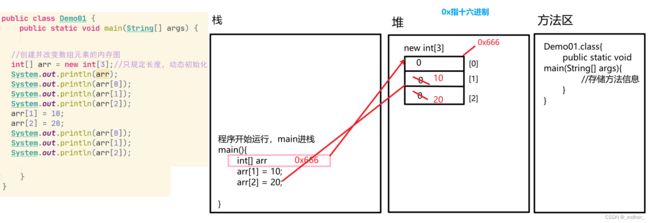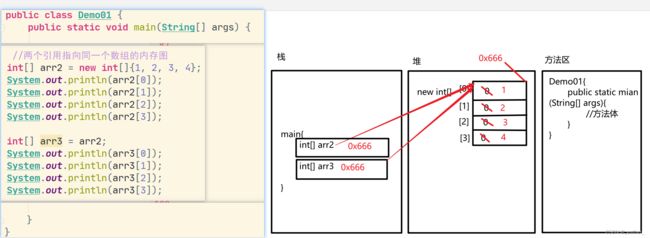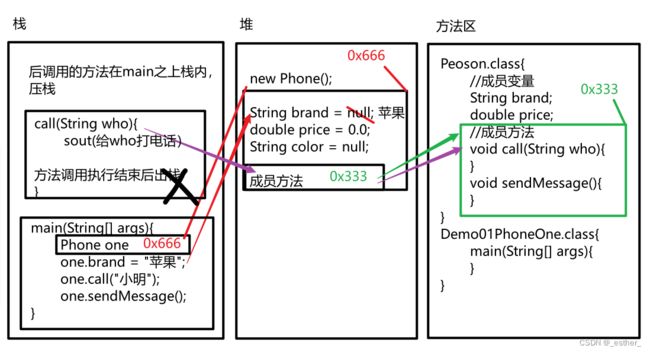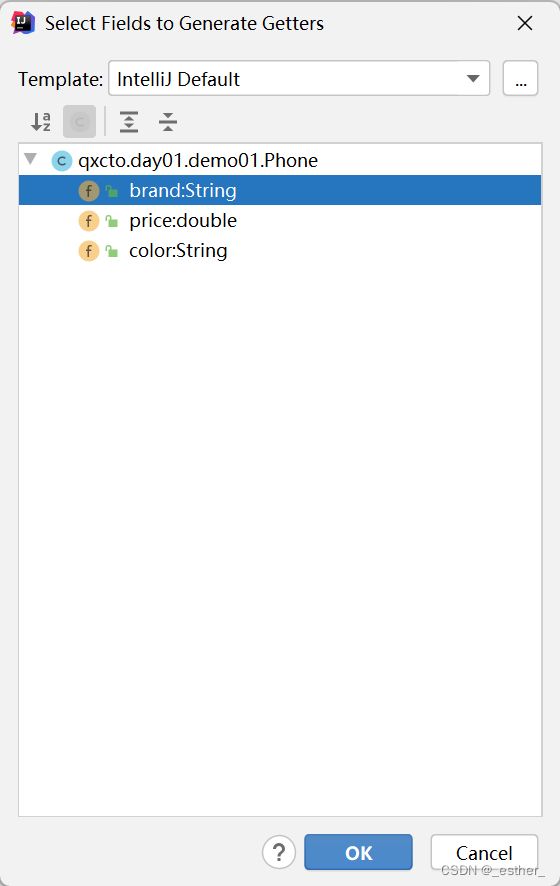【JavaSE P1~P147】2023-10不熟悉的点,复习(1常用快捷写法, 2不太熟的概念,3数组内存图,4对象,5ArrayList 集合,6字符串,7静态static关键字)
目录
- 1 常用快捷写法
-
- java中输出换行的6种写法
- 2 不太熟的概念
-
- 进制
- 命名规则
- 基本数据类型极其计算
- 逻辑运算符
- 编译器优化
- 数组3种初始化方式
- 3 数组内存图
- 4 对象
-
- 对象内存图
- Getter/Setter快捷写法
- this 关键字
- 构造方法
- JavaBean的四个标准
- API 概述和使用
- Scanner类
- 匿名对象
- Random生成随机数
- 对象数组
- 5 ArrayList 集合
-
- 集合练习题1:生成6个1~33之间的随机整数,添加到集合,并遍历
- 集合练习题2:自定义4个学生对象,添加到集合,并遍历
- 集合练习题3 :按指定格式遍历集合字符串即ArrayList
- 集合练习题4:筛选集合中的随机数
- 6 字符串
-
- 字符串的3+1种构造方法
- 字符串的常量池
-
- equals和==
- 字符串的获取相关方法
- 字符串的截取方法
- 字符串的转换相关方法
- 字符串的分割方法
- 字符串练习
- 7 静态static关键字
-
- 静态static的内存图
- 静态代码块
1 常用快捷写法
shift + F6 批量替换变量名
Alt +insert 打开Generate,快速生成构造器和Getter,Setter
Alt + Enter 对已经用的类,自动导包
fori + enter 快速生成循环

array.fori 快速生成循环遍历数组array
自动生成接收返回值的变量: 对于调用有返回值的方法,alt + enter选local那一项,修改变量名enter确定


同理:list.fori 快速生成遍历ArrayList的for循环(ArrayList list)
java中输出换行的6种写法
public class LineBreak {
public static void main(String[] args) {
System.out.print("不换行");
System.out.print("第一种换行方式\n");
System.out.print("第二种换行方式"+"\n");
System.out.printf("%s","不换行");
System.out.printf("%s\n","第三种" );
System.out.printf("%s%n","第四种");
System.out.printf("%s","第五种"+"\n");
System.out.println("第六种");
}
}
不换行第一种换行方式
第二种换行方式
不换行第三种
第四种
第五种
第六种
2 不太熟的概念
进制
- HEX 16进制 DEC 10进制 OCT 进制 BIN 2进制
命名规则
* 标识符硬命名规则:
1.可用26个英文字母大小写 0-9 $ _
2.不能以数字开头
3.不能是关键字
* 软规则:
1.类名,大驼峰
2.变量名,方法名,小驼峰
基本数据类型极其计算
-
float 和 long 赋值时后跟F或L,最好大写因为l与1容易混淆
-
不同数据类型的运算注意点:
数据范围和字节数不一定相关,float 4字节,long 8字节。但flaot 使用科学计数法
自动类型转化,是数据范围从小到大
强制类型转化,是数据范围从大到小,可能会精度损失,或者数据溢出
❤byte/short/char类型数据在计算时会自动提升为int,所以接收方必须是int或将结果强转
取模只针对整数,其他取模没意义
❤运算当中有不同类型的数据,结果将会是数据类型范围大的那种
❤对于String类型数据+为链接,后续加到的都为字符串
除非用小括号优先级最高,会先加再链接
例如:
System.out.println(50 + 70 + "str"+ 30 + 70);//120str3070
System.out.println("eat" + (40 + 50));//eat90
- ❤注意复合赋值运算符隐含了一个强制类型转化
- byte += 6;//是正确写法,相当于byte + int 要运算所以byte提升为int,运算包括加减乘除,取模。相当于 int + int = int ,直接写
byte = 6 + byte错。
- 数据类型的默认赋值:
整型 0
浮点型0.0
字符型 ‘\u0000’
布尔型 false
引用型 null
逻辑运算符
- 逻辑运算符 && || 短路,即左边条件若能判断结果就不运行右边条件
- 逻辑与或可连续比较多个条件 A && B && C ,< > 不可以 连续写,只能比较两个
- ❤三元运算符 ?:;结果必须被使用
编译器优化
-
❤byte/char/short 赋值时若右侧全为常量,如果右侧比较小,会隐含的补上一个强转。 如果右侧值超过,则报错
-
switch case 匹配到哪一个case就从哪一个位置向下执行,直到遇到break或整体结束
-
三种循环里,若条件从未满足,do -while 至少会执行一次
-
在IDEA中,delete一个Module,外部打开project打开还是存在的,怎么导入一个外部保存的Module
file-project structure + import module setup sdk即可 -
方法的三种调用形式,单独调,打印调,赋值调。void类型只能单独调
-
一个方法中可以有多个return,但必须保证同时只走一个return
-
❤重载: 多个方法的名称一样,但参数列表不一样
与参数名称无关,与返回值类型无关
数组3种初始化方式
- 动态初始化(指定长度)、静态初始化(指定内容)、省略式静态初始化
静态初始化可以省略写,但不可分为两步写。另外两个可以分为两步写
int[] array1 = new int[3];
int[] array11;
array11 = new int[4];
int[] array2 = new int[]{3,4,5};
int[] array22;
array22 = new int[]{3,4,5};
int[] array3 ={1,2,3};
- 打印数组的方法 Arrays.toString(arr) 格式:[1,2,3]
- 光定义没有new就是没初始化
- 数组一旦创建,程序运行期间,长度不可改变
- String也是,不会改变,属于常量,如果改变一定是引用改变了指向的地址
- 数组作为参数和返回值都是传递地址
3 数组内存图
- ❤方法的运行要进栈,存放局部变量,方法的参数,或者是方法{}内部的变量。局部变量不赋值无法使用,没有默认值
- 凡是new出来的东西,都在堆当中,堆内存中的东西都有一个地址值,16进制,都有默认值
- 方法区:存储.class信息,包含方法的信息。
- 定义数组并赋值时的内存图
int[] arr = new int[3];//只规定长度,动态初始化
System.out.println(arr);
System.out.println(arr[0]);
System.out.println(arr[1]);
System.out.println(arr[2]);
arr[1] = 10;
arr[2] = 20;
System.out.println(arr[0]);
System.out.println(arr[1]);
System.out.println(arr[2]);
2.两个引用指向同一个数组
//两个引用指向同一个数组的内存图
int[] arr2 = new int[]{1, 2, 3, 4};
System.out.println(arr2[0]);
System.out.println(arr2[1]);
System.out.println(arr2[2]);
System.out.println(arr2[3]);
int[] arr3 = arr2;
System.out.println(arr3[0]);
System.out.println(arr3[1]);
System.out.println(arr3[2]);
System.out.println(arr3[3]);
- 数组一旦创建,运行期间不可改变。
int[] arrC = new int[3];
arrC = new int[5];//长度改变
//等于创建了一个新的数组
4 对象
面向过程:需要实现一个功能的时候,详细处理每一个细节
面向对象:找一个已经具有该功能的人,来帮我做事
- 成员变量是直接定义在类当中的,在方法外边
- 对象的创建及使用
1.导包,import 包名称.类名称对于和当前类属于同一个包的情况,省略导包语句不写。注意:使用同一个包下类中的静态方法时,要导包import static 包名称.类名称.方法名或*所有方法
2.创建,格式:类名称 对象名 = new 类名称();
3.使用,对象名.成员变量名,对象名.成员方法名
对象内存图
- 一个手机类及其测试练习
public class Phone {
public String brand;
public double price;
public String color;
public Phone() {
}
public Phone(String brand, double price, String color) {
this.brand = brand;
this.price = price;
this.color = color;
}
//成员方法
public void call(String who){
System.out.println("给"+who+"打电话");
}
public void sendMessage(){
System.out.println("发信息");
}
}
public class Demo01PhoneOne {
public static void main(String[] args) {
Phone one = new Phone();
one.brand = "苹果";
one.price = 8799.0;
one.call("小明");
one.sendMessage();
System.out.println(one.brand);
System.out.println(one.price);
System.out.println(one.color);
}
}
给小明打电话
发信息
苹果
8799.0
null
-
两个对象使用同一个方法
根据调用方法的顺序,依次压栈运行方法,栈中后调用的方法在main方法之上(main方法没运行完,所以还在栈中)。若方法体运行完毕则出栈
可见两对象调用同一个方法时,不产生任何联系,
要产生联系:两个对象名称(对象的引用名)指向同一个对象(对象空间),即one和two指向的地址相同,相当于一个对象两个名称。
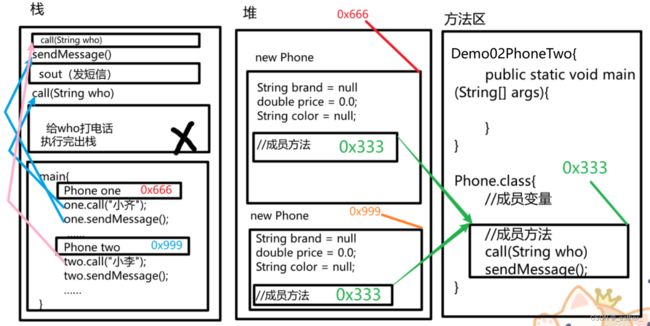
-
使用对象作为方法的参数或返回值同理
传递的都是对象的地址,每次new一个对象都在堆中,栈中运行方法要赋值或用到对象,就赋值为该对象空间的地址,根据地址访问到对象空间进行使用。Getter/Setter快捷写法
-
Code -> Generate或者alt + Insert
- Generate -> Constructor 为构造器
-> Getter 方法
-> Setter 方法
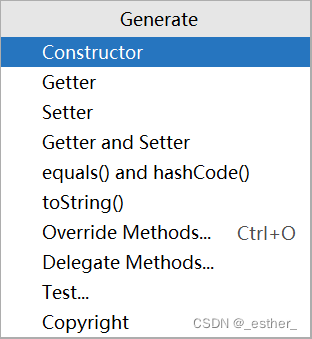
无参构造选 select none,全参构造 ctrl多选所有参数
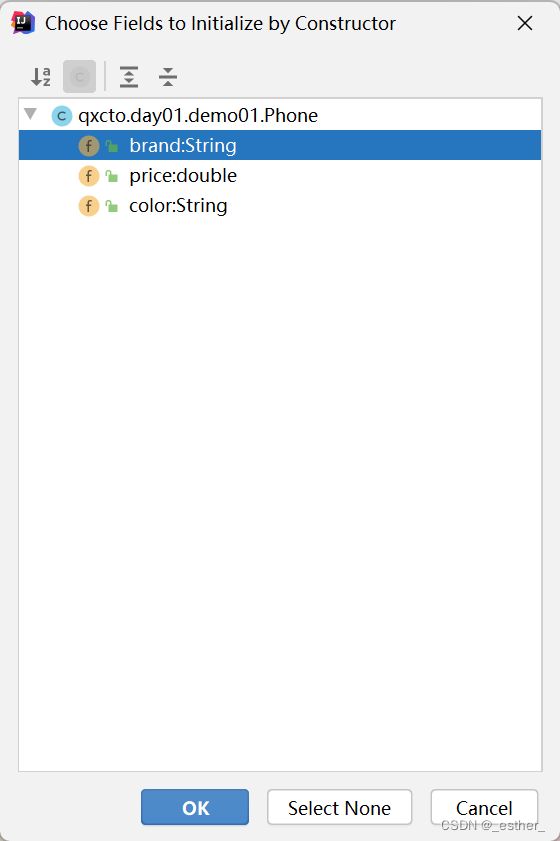
- Getter同理,生成哪个成员变量的方法选哪个变量。Ctrl多选
this 关键字
- 当方法的局部变量和累的 成员变量重名时,“就近原则”优先使用局部变量
- 要访问本类当中成员变量,用 this.成员变量名
- 通过谁调用的方法,谁就是this
构造方法
是专门用来创造对象的方法,当用new来创建对象时,就是在调用构造方法
格式:
public 类名称(参数类型 参数名称){
方法体
}
1.构造方法的名称必须和所在类名完全一样
2.构造方法不要写返回值类型,void都不写
3.不能return一个具体的返回值,可以return;表结束
4.如果没写任何构造方法,编译器会默认送一个构造方法,没有参数,方法体什么都不做
5.一旦编写了至少一个构造方法,那么编译器将不再送这个默认无参构造。
6.构造方法可重载
JavaBean的四个标准
- 所有成员变量都要使用private修饰
- 编写一个无参数的构造方法
- 写一个全参构造器,一个无参构造器
- 每一个成员都要写一对getter,setter
对于基础类型boolean写getter方法需要写为isXxx,其他都写为getXxx,setter统一写setXxx
API 概述和使用
使用一个类:
1.导包:package语句后 import 包路径.类名称 class语句前,若要用的目标类和当前类位于同一个包下,省略导包。java.lang包下的内容不需要导包,其他的包都需要import语句。
2.创建:类名称 对象名 = new 类名称();
3.使用:对象名.成员方法名();
Scanner类
导包 import java.util.Scanner;
String next() 查找并返回此扫描仪的下一个完整令牌。
int nextInt() 将输入的下一个标记扫描为 int 。
public class Demo01Scanner {
public static void main(String[] args) {
Scanner sc = new Scanner(System.in);
System.out.println("输入一个int给sc");
int num = sc.nextInt();
System.out.println("输入一个String给num");
String str = sc.next();
System.out.println("输出接收的sc,num");
System.out.println(num + "," + str);
}
}
练习一:输入两个int数字,并且求出和值
public class Exercise01InputSum {
public static void main(String[] args) {
inputSum();
}
public static int inputSum(){
Scanner sc = new Scanner(System.in);
System.out.println("输入两个整数");
int num1 = sc.nextInt();
int num2 = sc.nextInt();
System.out.println("总和" + num1 + num2);
return num1 + num2;
}
}
练习二,输入三个数,求max先判断前2个哪个大,再把最大的跟第3个比较
public class Exercise02InputMax {
public static void main(String[] args) {
inputMax();
}
public static double inputMax(){
System.out.println("输入3个整数");
Scanner sc = new Scanner(System.in);
double num1 = sc.nextDouble();
double num2 = sc.nextDouble();
double num3 = sc.nextDouble();
double max = num1 < num2 ? num2 : num1;
max = max < num3 ? num3 : max;
System.out.println("max:" + max);
return max;
}
}
匿名对象
匿名对象只能使用唯一的一次,下次再用不得不再创建一个新对象
public class Demo1Anonymous {
public static void main(String[] args) {
Person one = new Person();
one.name = "芭比";
new Person().name = "肯";
one.showName();//我叫null
new Person().showName();//我叫芭比
}
}
- 匿名对象做参数和返回值
public class Demo2ParamReturn {
public static void main(String[] args) {
Scanner sc = new Scanner(System.in);
methodParam(sc);
//用匿名对象简化写法
methodParam(new Scanner(System.in));
}
public static void methodParam(Scanner sc){
String str = sc.next();
System.out.println(str);
}
}
public class Demo2ParamReturn {
public static void main(String[] args) {
Scanner sc = methodReturn();
sc.next();
}
public static Scanner methodReturn(){
// Scanner sc = new Scanner(System.in);
// return sc;
//简化写法
return new Scanner(System.in);
}
}
Random生成随机数
导包 import java.util.Random;
protected int next(int bits) 生成下一个伪随机数。
int nextInt(int bound) 返回伪随机的,均匀分布 int值介于0(含)和指定值(不包括),从该随机数生成器的序列绘制。
对象数组
array[1].getName(); 写法正确,根据数组用到对象的方法✔
5 ArrayList 集合
- 数组的长度不可以发生改变,ArrayList 集合的长度可以随意变化
ArrayList指泛型中
泛型:装在集合当中的所有元素, 全都是统一的类型
注意:泛型只能是引用类型,不能是基本类型- jdk 1.7开始,右侧的尖括号内部可以不写内容,但<>本身还是要写
ArrayList右侧可以不写泛型内容,但左侧一定要写,这个算是标准写法list = new ArrayList<>(); - 对于ArrayList直接打印的不是地址值,而是[内容],为空则[],一般为
[元素1,元素2,元素3,元素4] - ArrayList打印
public static void main(String[] args) {
ArrayList<String> list1 = new ArrayList<>();
list1.add("哈哈");
list1.add("呵呵");
System.out.println(list1);//[哈哈, 呵呵]
}
- ArrayList常用方法和遍历
public boolean add(E e)向集合中添加元素,参数类型和泛型一致;返回值boolean代表是否添加成功
public E remove(int index)根据索引删除,返回删除的元素。(索引从0开始)
public int size()获取长度,返回值是集合中包含的元素个数
public E get(int index) 返回此列表中指定位置的元素。
list.fori 快速生成遍历循环
- 因为泛型只能是引用类型,不能是基本类型,因为集合存的是地址。所以基本来兴对应使用“包装类”
- 引用类型都位于java.lang包下,所以无需导包
| 基本类型 | 包装类 |
|---|---|
| byte | Byte |
| short | Short |
| int | Integer |
| long | Long |
| float | Float |
| double | Double |
| char | Character |
| boolean | Boolean |
从JDK1.5开始,支持自动装箱,自动拆箱
自动装箱:基础类型->包装类
自动拆箱:包装类->基础类型
集合练习题1:生成6个1~33之间的随机整数,添加到集合,并遍历
public class Exercise1List {
public static void main(String[] args) {
for (int n = 0; n < 1000; n++) {//测试100次
Random r = new Random();
ArrayList<Integer> list = new ArrayList<>();
for (int i = 0; i < 6; i++) {
int num = r.nextInt(33) + 1;
list.add(num);
}
System.out.println(list);
}
}
}
集合练习题2:自定义4个学生对象,添加到集合,并遍历
public class Exercise2List {
public static void main(String[] args) {
Student stu1 = new Student("barbie",true,"研二");
Student stu2 = new Student("ken",false,"大一");
Student stu3 = new Student("小明",true,"一年级");
Student stu4 = new Student("小李",false,"幼儿园");
ArrayList<Student> list = new ArrayList<>();
list.add(stu1);
list.add(stu2);
list.add(stu3);
list.add(stu4);
for (int i = 0; i < list.size(); i++) {
System.out.println(list.get(i).name);
}
}
集合练习题3 :按指定格式遍历集合字符串即ArrayList
- 定义以指定格式打印集合的方法(ArrayList类型作为参数)使用{}扩起集合,使用@分隔元素,
- 格式参照{元素1@元素2@元素3@元素4}
public class Exercise03List {
public static void main(String[] args) {
ArrayList<String> list = new ArrayList<>();
list.add("一");
list.add("二");
list.add("三");
printArray(list);
}
public static void printArray(ArrayList<String> list){
System.out.print("{");
for (int i = 0; i < list.size(); i++) {
if(i == list.size() - 1){
System.out.print(list.get(i));
}else{
System.out.print(list.get(i) + "@");
}
}
System.out.println("}");
}
}
集合练习题4:筛选集合中的随机数
- 用一个大集合存入20个随机数字,然后筛选其中的偶数,
- 放到小集合当中。要求使用自定义的方法来实现筛选,集合当返回值
public class Exercise04List {
public static void main(String[] args) {
System.out.println(evenNumber(20));
}
//参数:确定传入大集合的随机数个数
public static ArrayList<Integer> evenNumber(int size){
ArrayList<Integer> maxList = new ArrayList<>();
for (int i = 0; i < size; i++) {
Random r = new Random();
maxList.add(r.nextInt());
}
System.out.println(maxList);
ArrayList<Integer> minList = new ArrayList<>();
for (int i = 0; i < maxList.size(); i++) {
if(maxList.get(i) % 2 == 0){
minList.add(maxList.get(i));
}
}
return minList;
}
}
6 字符串
在java.lang包下,所以不用导包。
程序中所有的双引号字符串,都是String类的对象(就算没有new也是)
字符串的特点:
1.内容永不可变
2.因为字符串内容不可变,所以可以共享
3.字符串效果上相当于是char[]字符数组,但是底层原理是byte[]字节数组
字符串的3+1种构造方法
- 1
public String();创建一个空白字符串, 不含有任何内容 - 2
public String(char[] array);根据字符数组的内容,来创建对应的字符串 - 3
public String(byte[] array);根据字节数组的内筒,来创建对应的字符串 - 1种直接创建
String str = "Hello";注意:直接写上双引号,就是字符串对象。只要是字符串一定是对象
字符串的常量池
public boolean equalsIgnoreCase(String str);//忽略大小写进行内容比较
equals和==
- ==
对于基本数据类型比较 内容
对于引用类,只有是同一个对象才true(比较的是对象的内存地址) - equals
只能比较引用对象,普通类对象,只有同为同一个对象才是true
但对于File,String,Data和包装类,是比较内容
public class Demo2ConstantPools {
public static void main(String[] args) {
String str1 = "abc";
String str2 = "abc";
char[] charArray = {'a', 'b', 'c'};
String str3 = new String(charArray);
System.out.println(str1 == str2);//true
System.out.println(str2 == str3);//false
}
}

程序当中直接写上的双引号字符串,就在字符串常量池中。
即直接创建的字符串在常量池,若内容相同即为共享一个对象,3种构造方法的字符串不在常量池也不是共享,是由字符数组或字节数组在堆中转化为字节数组的地址,内容相同也不是同一个对象。
public class Demo2ConstantPools {
public static void main(String[] args) {
String str1 = "abc";
String str2 = "abc";
char[] charArray = {'a', 'b', 'c'};
String str3 = new String(charArray);
byte[] byteArray = { 'a', 'b', 'c'};
String str4 = new String(byteArray);
byte[] b2 ={'a', 'b', 'c'};
String str5 = new String(b2);
System.out.println(str1 == str2);//true
System.out.println(str2 == str3);//false
System.out.println(str3 == str4);//false
System.out.println(str4 == str5);//false
System.out.println(str1.equals(str2));//true
System.out.println(str2.equals(str3));//true
System.out.println(str3.equals(str4));//true
System.out.println(str4.equals(str5));//true
System.out.println(str1.equalsIgnoreCase("ABC"));//true
}
}
字符串的获取相关方法
public int length();字符个数
public String concat(String);将当前字符串和参数拼接返回
public char charAt(int index);获取指定索引位置的单个字符(从0开始)
public int indexOf(String str);查出参数字符串在本字符串中首次出现的索引位置,没有就return -1;
注意:concat方法只会把拼接的结果返回,并不改变调用方法的字符串。除非原字符串接收他的返回值
字符串的截取方法
public String substring(int index);截取从参数位置一直到字符串末尾。返回新字符串
public String substring(int begin, int end);截取从begin开始一直到end结束中间的字符串。(按照索引从0开始对应 每一个字符,截取为 [begin,end))
字符串的转换相关方法
public char[] toCharArray();将当前字符串拆分为字符数组作为返回值
public byte[] getByte();获得当前字符串底层的字节数组
public String replace(CharSequence oldString, CharSequence newString); 将所有出现的老字符替换成为新的字符串,返回替换后的新字符串(CharSequence简单理解为可以接受String类型)
字符串的分割方法
public String[] split(String regex);按照参数的规则将字符串切分成为若干部分
注意: 无法根据.划分做参数,split方法的参数其实是一个正则表达式,如果按照英文句“.”必须写“\\.”
public class Demo3StringMethod {
public static void main(String[] args) {
//字符串的获取相关方法-------------------------------------------------------
String str1 = "Hi~Barbie";
System.out.println(str1.length());
System.out.println(str1.concat("Hi~Ken"));
System.out.println("索引3的字符" + str1.charAt(3));
str1 = str1.concat("bie~hello java $ rusty lake is fate 1 larua is blossom");
System.out.println("str1 : " + str1);
System.out.println("第一次出现bie的索引位置:" + str1.indexOf("bie"));
//字符串的截取方法
System.out.println("从4截取" + str1.substring(4));
System.out.println("从[7,13)截取" + str1.substring(7,13));
//字符串的转换相关方法
char[] ch = str1.toCharArray();
System.out.println("char数组:" + ch);
System.out.println(Arrays.toString(ch));
byte[] by = str1.getBytes();
System.out.println("by数组:" + by + Arrays.toString(by));
for (int i = 0; i < by.length; i++) {
System.out.print(by[i] + ",");
}
System.out.println();
String str2 = "Hoow doo yoou doo?";
System.out.println("str2" + str2);
System.out.println(str2.replace("oo", "*"));
//字符串的分割方法
String[] str3 = str1.split("a");
System.out.println("根据a划分str1:"+ str1);
for (int i = 0; i < str3.length; i++) {
System.out.println(str3[i]);
}
}
}
字符串练习
package qxcto.day24.demo1;
/**
* Created with IntelliJ IDEA.
*
* @Author: 雪雪子
* @Date: 2023/10/03/18:24
* @Description: 定义一个数组,把数组{1,2,3}按照指定格式拼接成一个字符串。
* 格式:[word1#word2#word3]
*
* 思路:先把数组转化为字符串String,但注意分隔需要加逗号到字符串,再用split替换为#
* 此处默认为字符串数组
*/
public class Exercise01String {
public static void main(String[] args) {
String[] strArr = {"hello", "甄嬛", "流朱", "barbie"};
System.out.println(fromArrayToString(strArr));
}
public static String fromArrayToString(String[] array){
String str = "[";
for (int i = 0; i < array.length; i++) {
if(i == array.length - 1){
str += array[i];
}else{
str += array[i] + "#";
}
}
str += "]";
return str;
}
}
package qxcto.day24.demo1;
import java.util.Scanner;
/**
* Created with IntelliJ IDEA.
*
* @Author: 雪雪子
* @Date: 2023/10/03/18:45
* @Description: 统计输入的字符串中各种字符的个数,键盘输入一个字符串,
* 并且统计其中各种字符出现的次数。种类有:大写字母、小写字母、数字、其他。
*/
public class Exercise02String {
public static void main(String[] args) {
Scanner sc = new Scanner(System.in);
System.out.println("请输入任意字符串");
String str = sc.next();
int[] count = countChar(str);
System.out.println("str:" + str);
System.out.println("数字个数:" + count[0] + " 大写字母:" +
count[1] + " 小写字母:" + count[2] + " 其他:" + count[3]);
}
public static int[] countChar(String str){
char[] ch = str.toCharArray();
//计数器count
int[] count = new int[4];//4种,分别统计为数字,大写字母,小写字母,其他
for (int i = 0; i < ch.length; i++) {
if(ch[i] >= 48 && ch[i] <= 57){
count[0]++;
}else if(ch[i] >= 65 && ch[i] <= 90){
count[1]++;
}else if(ch[i] >= 97 && ch[i] <= 122){
count[2]++;
}else{
count[3]++;
}
}
return count;
}
}
7 静态static关键字
用于多个对象共享同一份数据的情况,例如,一个学生类Student,除过姓名成绩等不同的属性外,共同的属性应该为同一间教室,多个对象的教室属性,内容完全相同。无需作为对象成员变量,每次赋不同的值。只需赋值一次,多个对象共享即可。
一旦用了static关键字,那么这样的内容不在属于对象自己,而是属于类的,所以凡是本类的对象,都共享一份static变量或方法。
例如:定义学生类中学号为static,作用:每new一个学生对象,学号都自增统计学生数量
public class DemoStatic {
public static void main(String[] args) {
Student stu1 = new Student("barbie",true,18);
Student stu2 = new Student();
Student stu3 = new Student("奥罗拉",true,16);
Student stu4 = new Student("菲利普",false, 17);
stu3.showInfo();
stu2.showInfo();
stu4.showInfo();
}
}
学生学号:3 姓名:奥罗拉 是否女孩:true 年龄:16
学生学号:2 姓名:null 是否女孩:false 年龄:0
学生学号:4 姓名:菲利普 是否女孩:false 年龄:17
静态方法不属于对象,而是属于类。如果没有static关键字,那么必须首先创建对象,然后通过对象才能使用他。
MyClass obj = new MyClass();
obj.method();
obj.methodStatic();//不推荐,会误以为是普通成员方法
MyClass.methodStatic();
对于静态方法来说,可以通过对象名进行调用,也可以直接通过类名称来调用
不推荐用对象调用静态方法,因为会误以为是普通成员方法,且编译后也会被javac翻译成为类名称,.静态方法名
有static,都推荐使用类名称进行调用。
对于本类当中的静态方法,可以省略类名称直接调用。
注意:1.静态不能直接访问非静态
2. 静态方法当中不能用this
因为在内存当中是先有得静态内容,后有的非静态内容。
this代表当前对象,通过谁调用的方法 ,谁就是当前对象。但静态方法不用对象
静态static的内存图
静态方法就算写为对象.方法,对象.属性。编译期间也会翻译为类.方法或类.属性,然后去方法区找。跟对象无关
public class Student {
//为什么定义两个,因为id属于学生的属性,属于对象,每个对象不一样。但idCount属于属于类
//每次new该类对象才自增,不保存加过的数
private static int idCount = 0;
private int id = 0;
static String room = "一年级一班";
String name;
boolean girl;
int age;
public Student(String name, boolean girl, int age) {
this.id = ++idCount;
this.name = name;
this.girl = girl;
this.age = age;
}
public Student(){
this.id = ++idCount;
}
public void showInfo(){
System.out.println("学生学号:" + this.id + " 姓名:" + this.name + " 是否女孩:" + this.girl + " 年龄:" + this.age);
}
public static void setRoom(String room) {
Student.room = room;
}
public void setName(String name) {
this.name = name;
}
public void setGirl(boolean girl) {
this.girl = girl;
}
public void setAge(int age) {
this.age = age;
}
public static int getIdCount() {
return idCount;
}
public int getId() {
return id;
}
public static String getRoom() {
return room;
}
public String getName() {
return name;
}
public boolean isGirl() {
return girl;
}
public int getAge() {
return age;
}
}
public class Demo02Static {
public static void main(String[] args) {
Student.room = "大一一班";
Student one = new Student("小刘", false, 20);
System.out.println("one的姓名:" + one.getName());
System.out.println("one的教室:" + Student.getRoom());
System.out.println("one的年龄:" + one.getAge());
System.out.println("one的学号:" + one.getId());
System.out.println("============================");
Student two = new Student("小李", true, 12);
System.out.println("two的姓名:" + two.getName());
System.out.println("two的教室:" + Student.getRoom());
System.out.println("two的年龄:" + two.getAge());
System.out.println("two的学号:" + two.getId());
System.out.println("学生人数:" + Student.getIdCount());
}
}

注意:根据类名称访问静态成员变量的时候,全程和对象没关系,只和类有关
静态代码块
特点:当第一次用到本类时,静态代码块执行唯一的一次。
静态内容总是优先于非静态,所以静态代码块比构造方法先执行
格式:
public class 类名称{
static{
//静态代码块的内容
}
}
静态代码块的典型用途:用来一次性地对静态成员变量进行赋值
